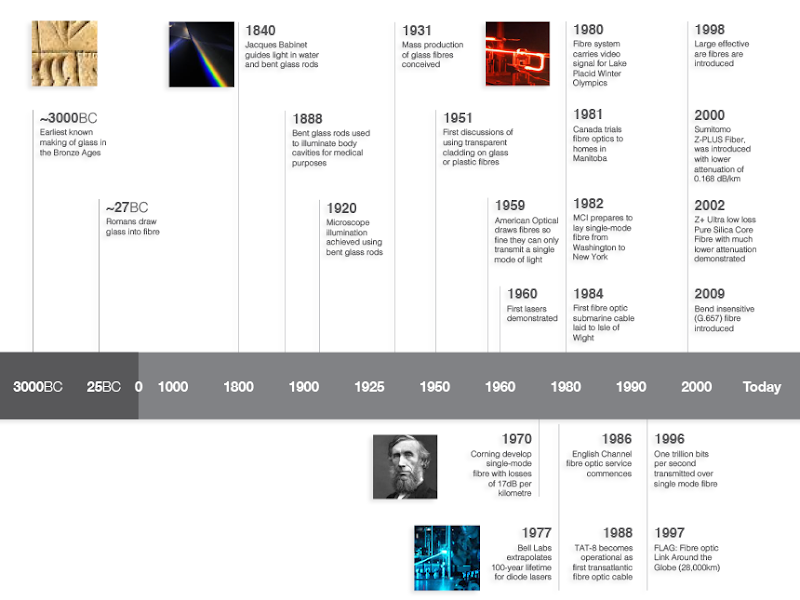FIBER OPTICS
Have you ever listened to the
word fiber optics or optical fiber? If you listened what is it? What is the use
of it? Where it is used? How does it work? Can you imagine the life without it?
How does it impact in our life? So, without any discussions I will tell you
about it?
Content: -
1.Introduction
2.History
3.Working
4.Types
5.Applications
6.Merits and demerits
7.Impact in today’s life
Introduction: -
While fibre technology has become very necessary in
today’s modern telecommunications networks, did you know that fibre optic
technology has been around for a very long time and is quite simple in concept.
Fiber
optics or optical fiber, means to the medium and the technology associated
with the transmission of information as light pulses along a glass or plastic
strand or fiber. Fiber optics is used for long-distance and high-performance data
networking.
A fiber
optic cable contains a number of glass fibers, from a few to hundreds. Surrounding the glass fiber core is another glass layer
called cladding. A layer that protects the cladding, and acts as the final protective layer for the individual fiber.
History: -
Working: -
It works on the
principal of total internal reflection, the data is transmitted through optical
fibre and is transmitted at a tremendous speed. Therefore, data moves through optical
fibre in the form of beam like light.
Fiber optics transmit data in the form of light particles or Photons that passes through a fiber optic cable. The glass fiber core and the cladding each have a different refractive index that bends incoming light at a certain angle. When light signals are sent through the fiber optic cable, they reflect away from the core and cladding in a series of zig-zag pattern bounces, to a process called total internal reflection. The light signals do not travel at the speed of light because of the denser glass layers, instead of traveling 30% slower than the speed of light.
Fiber optic cables are moving toward supporting up to 10-Gbps signals. Typically, as the bandwidth capacity of a fiber optic cable increases, the more expensive it becomes.
TYPES OF OPTICAL FIBER: -
There are two types of fibers ,single mode and multimode fiber.
Single
mode fiber is used for longer distances due to the smaller diameter of the
glass fiber which reduces the possibility for the reduction in signal
strength. The smaller opening can be mergeing the light into a single beam, which
offers a more direct route and allows the signal to travel a longer distance.
Single-mode fiber also has considerably higher bandwidth than multimode
fiber. The light source used for single-mode fiber is typically a laser. Single
mode fiber is usually more expensive since it requires precise calculations to
produce the laser light in a smaller opening.
Multimode fiber is used for shorter distances because the larger core opening allows light signals to bounce and reflect more along the way. The larger diameter allows multiple light rays to be sent through the cable at one time, which results in more data transmission. This also means that there is more possibility for signal loss, reduction. Multimode fiber optics typically use an LED to create the light pulse or rays.
Applications: -
Computer
networking uses fiber optics due to optical fiber's ability to transmit data
and provide high bandwidth. Similarly, fiber optics are frequently used in
broadcasting and electronics, to provide better connections and performance.
Internet and cable television are two of the more commonly found usages of
fiber optics.
Military and space industries also use optical fiber as a means of communication and signal transfer, furthermore it has ability to provide temperature sensing. Fiber optic cables are used due to their lighter weight and smaller size.
MERITS AND DEMERITS: -
Advantages include:
· Support of higher bandwidth capacities.
· Light can travel more distance without any boost.
·
They are less interference.
·
They can be submerged in water
·
Fiber optic cables are also stronger, thinner and
lighter than copper wire cables
· They do not need to be maintained or replaced frequently.
These disadvantages include:
·
Fiber optics price is high.
·
Glass fiber also requires more protection.
·
Installing new cables costs high.
·
Fiber optic cables are often more fragile.
Impact on Today’s
Life: -
By knowing all this we can say that , the optical fibers is playing a major role in the life of people now a days. We cannot imagine life without this, that means no internet, no networks, no satellite communications without it. Fiber optic carry information over great distances in no time and in safe towards the environment.
Few examples in daily use are:-
·
Computer networking – to boost communication speed.
·
Medical field – for surgery and dentistry.
·
Internet connection.
·
Enhancing cable TV.
·
Decorations.
·
Military and space applications – provides a
reliable, safe, and fast medium for data transmission.
·








Thanks for making us to know the origin of fiber optics in excellent work of explanation in this blog..
ReplyDeletegood work great information 👍👍
ReplyDeleteNICE WORK
ReplyDelete